
The Bottom Line
Introduction, Drive Specifications, Pricing and Availability
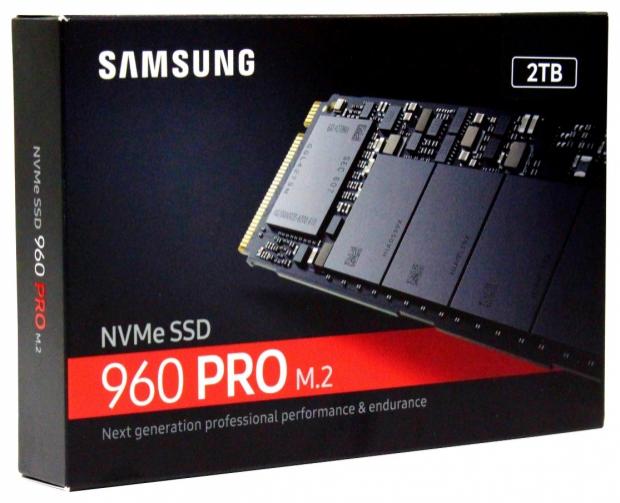
Once a year, Samsung manages to redefine performance in the consumer space. Last year Samsung introduced us to NVMe in the M.2 form factor with the launch of their 950 Pro. Despite the constraints of a tiny 22mm x 80mm form factor, the 950 Pro delivered performance that was significantly better than Intel's behemoth 750 Series SSDs. Cheaper, faster, and a far more appealing form factor than the Intel 750 made the 950 Pro the undisputed king of consumer SSDs. Competing M.2 NVMe SSDs have arrived on the scene this year, but none have been able to challenge the 950 Pro for supremacy.
The key to Samsung's performance advantage is their flash. Samsung's V-NAND 3D flash has proven to be a game changer. Samsung is way ahead of the curve when it comes to NAND flash technology. We are starting to see competing first generation 3D flash hit the market while Samsung is currently developing their fourth generation 3D NAND flash. Because of this, catching Samsung in terms of performance is unrealistic at this time. The only thing competing 3D flash hitting the market today has going for it is that it is cheap, and it has to be, because compared with Samsung's V-NAND, it is inferior in every way.
Samsung's second-generation consumer NVMe SSDs will appeal to professionals, enthusiasts, and consumers that are looking for more from their PC's. The 2TB MLC-based 960 Pro we have in the lab today delivers up to 3,500MB/s sequential read and 2,100MB/s sequential write speeds. That is a 40% improvement over the 950 Pro. Random performance gets a huge boost as well. The 960's random read performance is up to 47% better than the 950 Pro. Random write performance is up by a whopping 200% over the 950 Pro. At the heart of this massive performance increase is Samsung's second-generation NVMe controller, codenamed "Polaris."
Samsung's Polaris NVMe controller is a 5-core design that replaces the 3-core UBX controller found on the 950 Pro. The additional cores along with architectural improvements facilitate the huge performance advantage the 960 Pro brings to the table. The 960 Pro pairs the Polaris controller with Samsung's third-generation 48-layer V-NAND. The increased density of 48-layer V-NAND makes larger capacities possible on the 960 Pro. The 960 Pro will be available in three capacities, 512GB, 1TB, and the massive 2TB model we have on the bench. The 2TB 960 Pro is the world's first 2TB consumer M.2 SSD. Even more amazing than the sheer capacity, is that Samsung managed to pack all that capacity onto a single-sided 22mm x 80mm design.
A 2280 single-sided design is most desirable because it will fit into just about any laptop on the market with an M.2 PCIe slot. In the case of the 2TB model, Samsung was able to accomplish this feat through their advanced packaging technology. This technology allows Samsung to stack 16-32GB dies, resulting in a 512GB flash package. The 2TB model has four of these 512GB flash packages. Samsung calls four flash packages on a single side of an M.2 PCB a "Four Landing Design." This doesn't leave much real estate for the controller and DRAM cache package on a 2280 PCB, in fact, there is only enough room for the controller. Samsung solves this problem by employing a unique package-on-package design. Samsung's PoP design takes the DRAM cache package and stacks it on top of the controller to create a single integrated DRAM/controller package.
Typically, with performance increases comes increased thermal impact. To offset this, Samsung's 960 Pro uses 10% less power than the 950 Pro, and it is also outfitted with a unique thermally conductive label on the bottom of the PCB. This heat dissipating label has a thin copper layer that helps to shed heat faster than would be possible without the label. Also, the four landing design improves thermal characteristics because it can reduce heat generation per unit area. With these improved thermal characteristics, the 960 Pro can transfer up to 333GB of sequential data before thermal throttling kicks in - a 2x improvement over the 950 Pro.
To compliment the 960 Series SSDs, Samsung is introducing a new 2.0 version of their proprietary NVMe driver with the 960 Pro. The new driver is designed to ensure full compatibility and maximum performance for 960 users. Unfortunately, we do not have the new driver in-hand, so we instead utilized the 950 Pro driver for our testing. We expect that there will not be much of a performance difference between the two drivers, so we feel comfortable in presenting our results running on Samsung's version 1.1 NVMe driver. Samsung has also revamped their award winning Magician software. The new version of Magician offers a more personalized, intuitive interface along with a host of new features. Unfortunately, we do not have the new version in-hand, so we will have to show you the new interface and features when we are able to do so.
Specifications

Samsung's 960 Pro M.2 x 2280 NVMe SSD is available in three capacities: 512GB, 1TB, and 2TB. The 2TB model we have on the bench sports the following specifications:
- Sequential Read: up to 3,500 MB/s
- Sequential Write: up to 2,100 MB/s
- Max 4K Random Read Speed: up to 440,000 IOPS
- Max 4K Random Write Speed: up to 360,000 IOPS
- Max 4K QD1 Random Read Speed: up to 14,000 IOPS
- Max 4K QD1 Random Write Speed: up to 50,000 IOPS
- Endurance: 1,200 TBW
- MTTF: 1.5 Million Hours
- Warranty: 5-Year Limited Warranty
- Active Power Consumption: 5.8W Avg.
- DevSlp: 8mW
- Data Security: AES 256-bit for User Data Encryption, TGC/Opal
- SMART
- TRIM
- Garbage Collection
- Software: Magician, Migration, Samsung NVMe Driver
MSRP: 512GB = $329, 1TB = $629, 2TB = $1,299
Drive Details
Samsung 960 Pro 2TB M.2 NVMe PCIe SSD
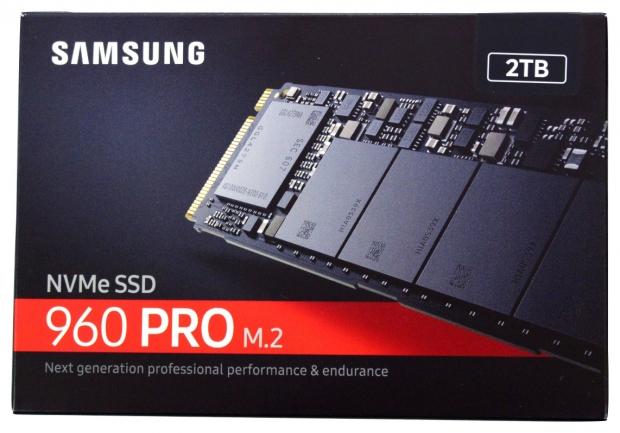
The front of the packaging is black and red themed. There is a picture of the drive without the manufacturer label. The enclosed drive's capacity is given on the top right corner on the front of the package.
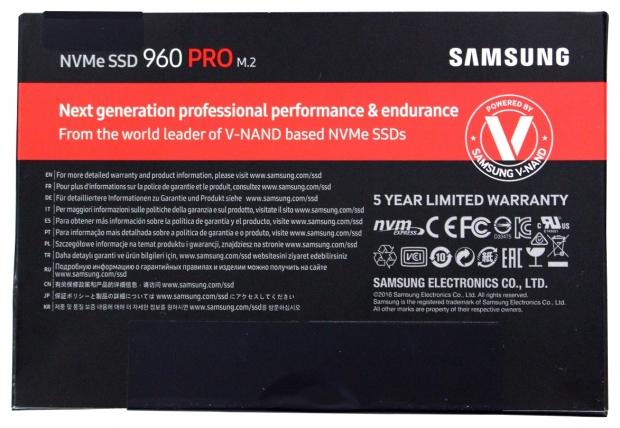
The rear of the packaging carries the same black and red theme as the front. The drive's V-NAND technology and five-year warranty are advertised here.
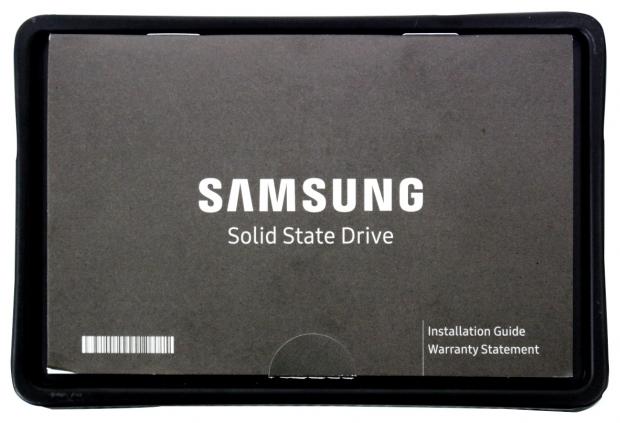
Inside of the packaging, the drive and instruction manual sit in a plastic tray. The drive is located under the instruction manual.

Removing the instruction manual exposes the drive itself.

The front of the drive has a manufacturer label that covers the flash packages and half of the controller/DRAM package.

The back of the drive features the thermally conductive label we touched on earlier.

With the label removed, we see four 512GB flash packages and the controller/DRAM package.
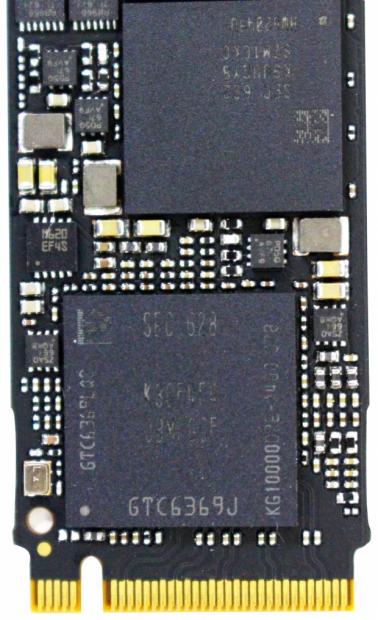
A close-in view of the drive's edge connector and integrated DRAM/controller package.
Test System Setup, & Drive Properties
Jon's Consumer PCIe SSD Review Test System Specifications
- Motherboard: ASRock OC Formula Z170 - Buy from Amazon / Read our review
- CPU: Intel Core i7 6700K @ 4.7GHz - Buy from Amazon / Read our review
- Cooler: Swiftech H2O-320 Edge - Buy from Amazon / Read our review
- Memory: Corsair Vengeance LPX DDR4 16GB 3200MHz - Buy from Amazon
- Video Card: Onboard Video
- Case: IN WIN X-Frame - Buy from Amazon / Read our review
- Power Supply: Seasonic Platinum 1000 Watt Modular - Buy from Amazon / Read our review
- OS: Microsoft Windows 10 Professional 64-bit - Buy from Amazon
- Drivers: Intel RAID option ROM version 14.6.0.1029 and Samsung version 1.1 NVMe driver
We would like to thank ASRock, Crucial, Intel, Corsair, RamCity, IN WIN, and Seasonic for making our test system possible.
Drive Properties
Samsung 960 Pro 2TB OS Disk 75% Full
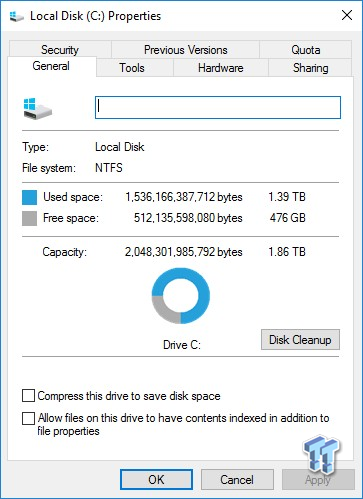
The majority of our testing is performed with our test drive as our boot volume. Our boot volume is 75% full for all OS Disk "C" drive testing to replicate a typical consumer OS volume implementation. We feel that most of you will be utilizing your SSDs for your boot volume and that presenting you with results from an OS volume is more relevant than presenting you with empty secondary volume results.
System settings: Cstates and Speed stepping are both disabled in our systems BIOS. Windows High-Performance power plan is enabled. Windows write caching is enabled, and Windows buffer flushing is disabled. We are utilizing Windows 10 Pro 64-bit OS (Build 14393) for all of our testing except for our MOP (Maxed-Out Performance) benchmarks where we switch to Windows Server 2008 R2 64-bit. Empty Windows 10 benchmark screenshots will also be shown on our MOP page.
Synthetic Benchmarks - ATTO & Anvil Storage Utilities
ATTO
Version and / or Patch Used: 2.47
ATTO is a timeless benchmark used to provide manufacturers with data used for marketing storage products.
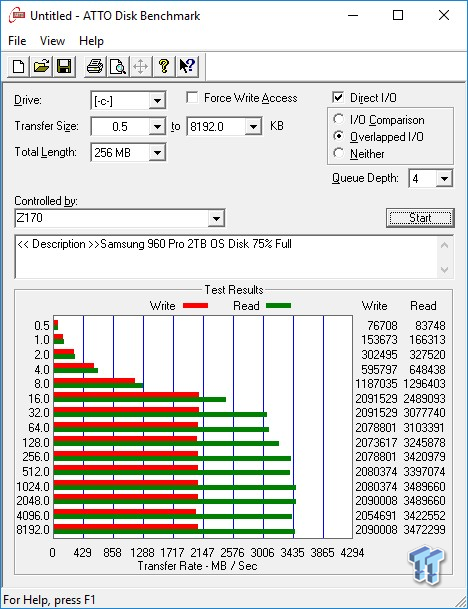
Sequential read/write transfers max out at an impressive 3,489/2,091 MB/s. Keep in mind this is our OS volume, and it is filled to 75% of its total capacity. We note the impressive performance at 4K transfers. The highest sequential read performance is achieved at 1MB transfers. The highest sequential write performance is achieved at 16KB transfers. It is also worth noting that we run ATTO at the default setting of QD4. Samsung gets their sequential numbers from the newest version CrystalDiskMark which runs sequentially at QD32.
Sequential Write
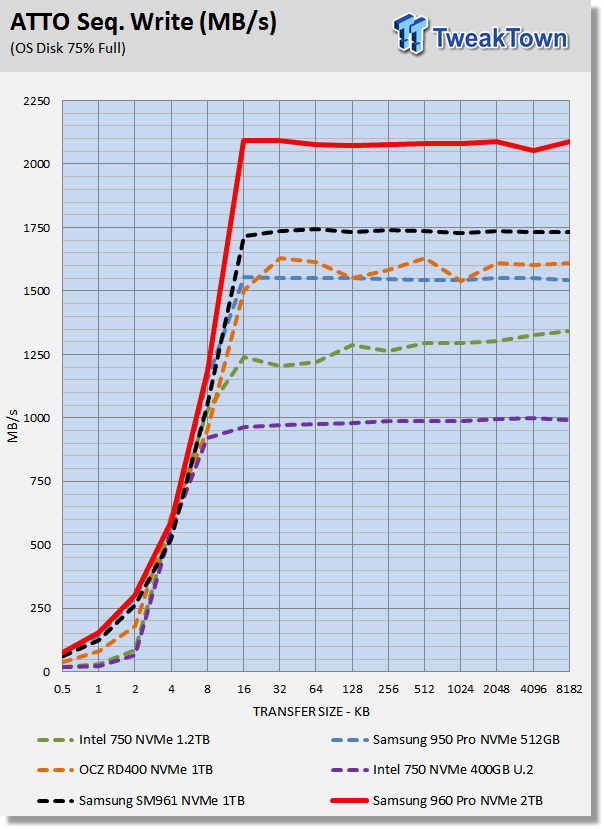
Samsung's 960 Pro delivers a new level of sequential write performance. The previous leader, Samsung's own SM961, is easily overpowered by the 960 Pro. The 960 Pro's performance curve is better than the competing SSD in our test pool, leading from start to finish at every transfer size tested.
Sequential Read
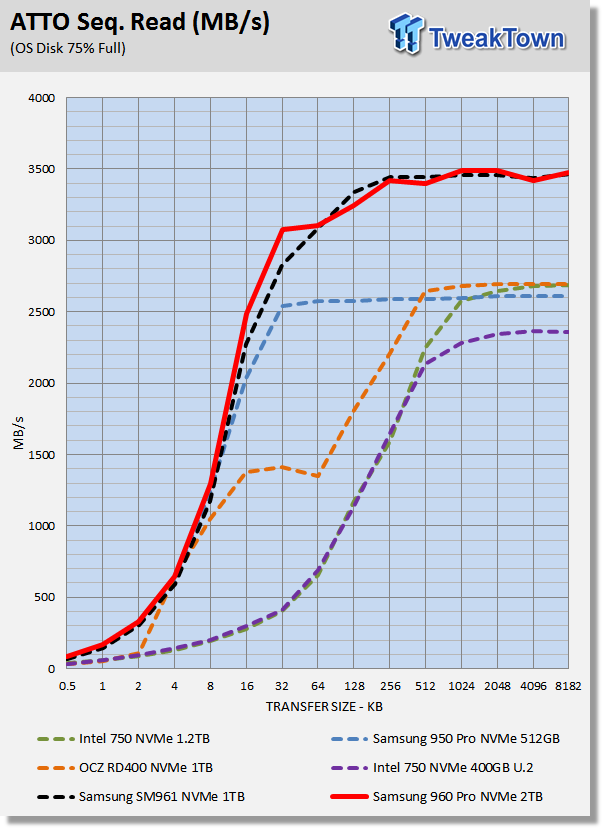
Samsung's SM961 is their OEM version of the 960 Pro. Both drives deliver similar sequential read performance, but the 960 Pro ramps up a bit faster. This new level of sequential read performance is getting close to maxing out the PCIe Gen3 x 4 interface which is theoretically 4GB/s with no overhead.
Anvil Storage Utilities
Version and / or Patch Used: 1.1.0
Anvil's Storage Utilities is a storage benchmark designed to measure the storage performance of SSDs. The Standard Storage Benchmark performs a series of tests; you can run a full test or just the read or write test, or you can run a single test, i.e. 4K QD16.
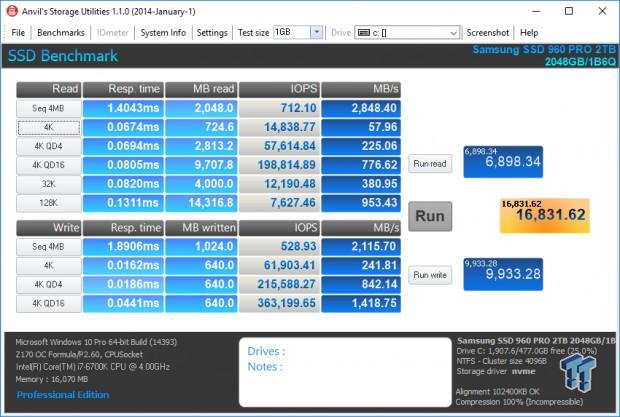
Scoring
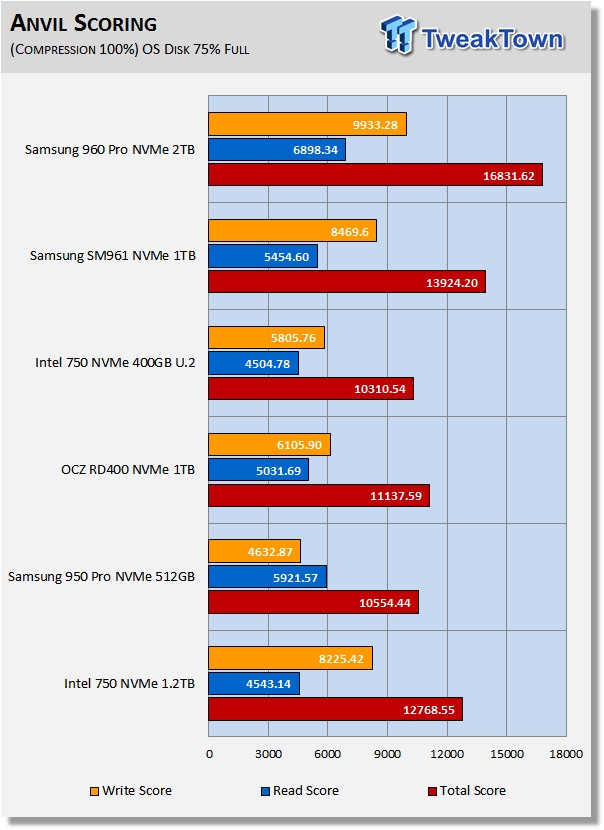
Anvil's scoring gives a good indication of a drive's overall performance. In terms of overall scoring, Samsung's 960 Pro 2TB sets a new lab record for client/consumer SSDs; doing so in spectacular fashion. Most of the increase in performance over the previous leader, the SM961, stems from Samsung's NVMe driver.
We did not use the Samsung NVMe driver when testing the SM961 because it is intended to run on the Windows in-box NVMe driver. Some of the scoring increase also comes from the 960 Pro inherently having better write performance than the SM961.
(Anvil) Read IOPS through Queue Depth Scale
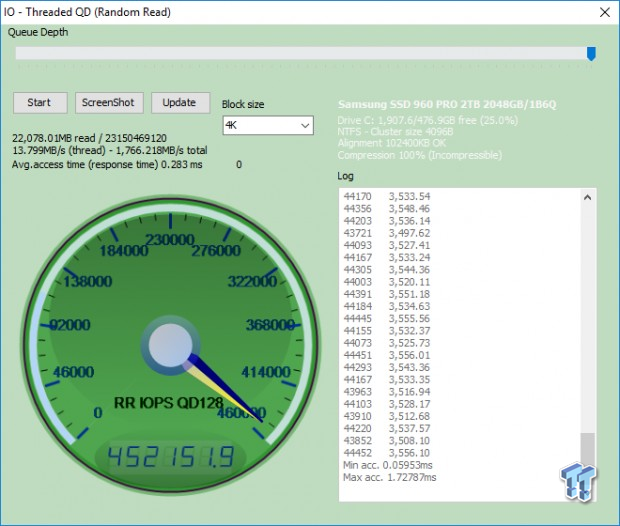
With our configuration, we attained 452K random read IOPS at QD128. This exceeds Samsung's factory specification of 440K. This is something we can point to as a reason why we are comfortable in presenting our results utilizing Samsung's NVMe driver designed for the 950 Pro.
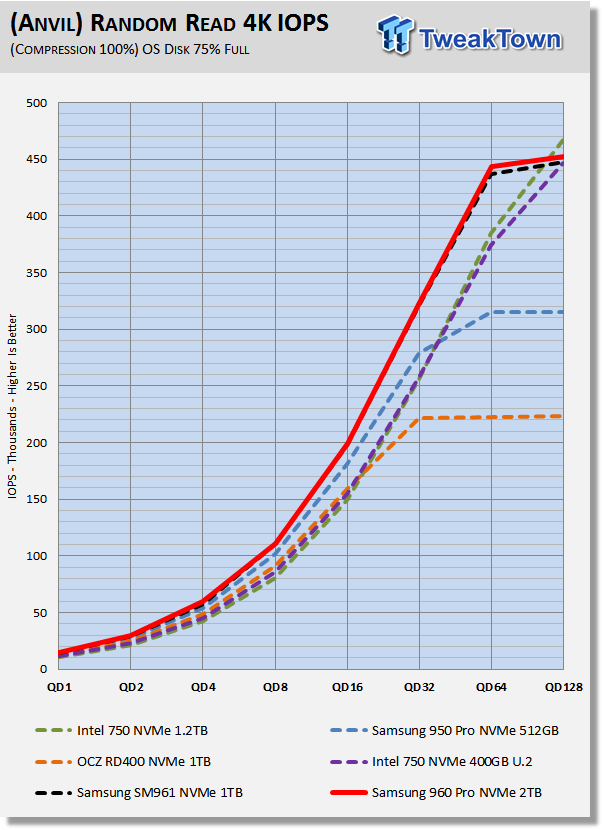
The 960 Pro and SM961 display an almost identical performance curve; as we would expect to see. Both drives dominate this testing at queue depths up to 64. Both display a much better performance curve than the rest of the drives in our test pool.
Intel's 750 1.2TB finishes the test with 470K IOPS at QD128. However, the 960 Pro and SM961 both deliver a far better performance curve than Intel's 750 1.2TB NVMe SSD.
(Anvil) Write IOPS through Queue Scale
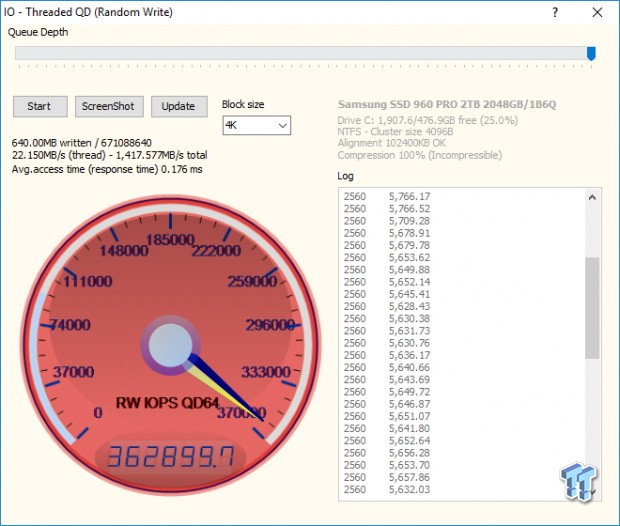
With our configuration, we are again able to exceed the 960 Pro's factory max random write performance specification, doing so at QD64. This again reinforces our belief that using Samsung's version 1.1 NVMe driver does not have a negative impact on performance.
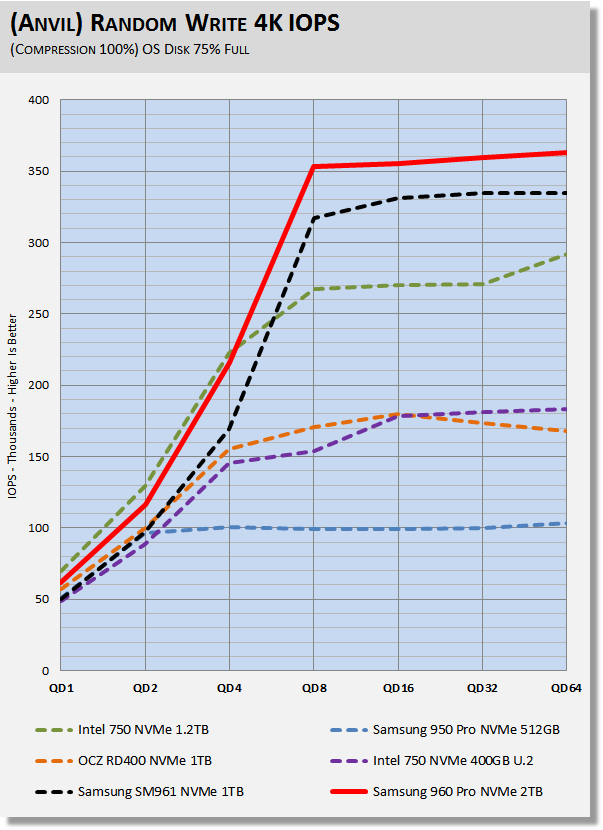
Intel's 1.2 TB 750 delivers the best performance up to QD4. At QD8-64, the 960 Pro takes a commanding lead. We note that the 960 Pro outperforms the SM961 significantly across the board. Much of this is due to the difference between the Windows 10 NVMe driver and Samsung's proprietary NVMe driver architecture.
We would point out that the Windows 10 NVMe driver is very bad for performance - even the Windows 8.1 NVMe driver is vastly superior. This is a clear demonstration of why a proprietary NVMe driver is an absolute must for maximum performance.
Synthetic Benchmarks - CrystalDiskMark & AS SSD
CrystalDiskMark
Version and / or Patch Used: 3.0 Technical Preview
CrystalDiskMark is disk benchmark software that allows us to benchmark 4K and 4K queue depths with accuracy. Note: Crystal Disk Mark 3.0 Technical Preview was used for these tests since it offers the ability to measure native command queuing at QD4.
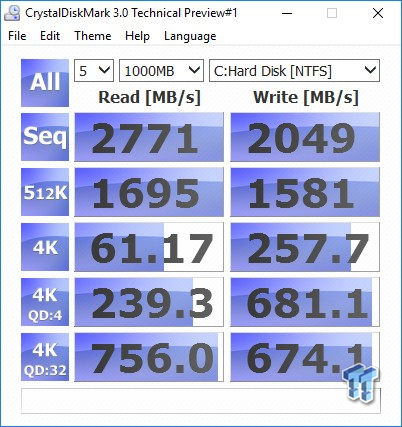
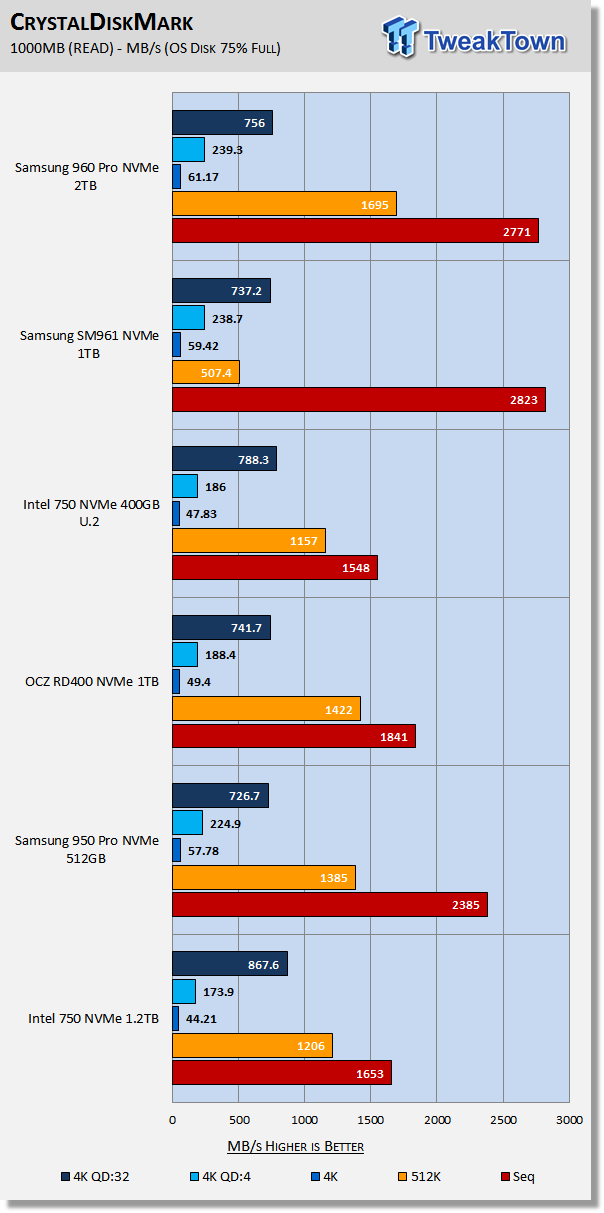
With this version of CDM, Sequential performance is measured at QD1 which is the reason sequential rates are lower than Samsung's quoted numbers. This version of CDM measures performance at 512K transfers, so let's focus on that for a moment. The SM961 is only able to muster 507.4 MB/s with 512K read transfers. This is far below that of the rest of the drives in our test pool. The reason? Windows 10 NVMe driver vs. a proprietary NVMe driver.
The Windows in-box NVMe driver tends to deliver slightly better sequential performance, but other than that, it falls woefully short in most other and more important performance metrics. The 960 Pro wins this test hands down.

This is a new lab record for sequential write performance on this version of CDM. Keep in mind that we are running the 960 Pro as our OS Disk and it is 75% full, which can have a negative impact on performance depending on which benchmark we are running. The 960 Pro is in a class of its own.
AS SSD
Version and / or Patch Used: 1.7.4739.38088
AS SSD determines the performance of SSDs. The tool contains four synthetic as well as three practice tests. The synthetic tests are to determine the sequential and random read and write performance of the SSD.
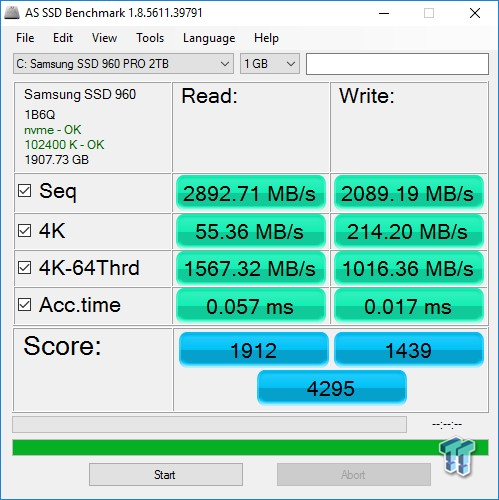
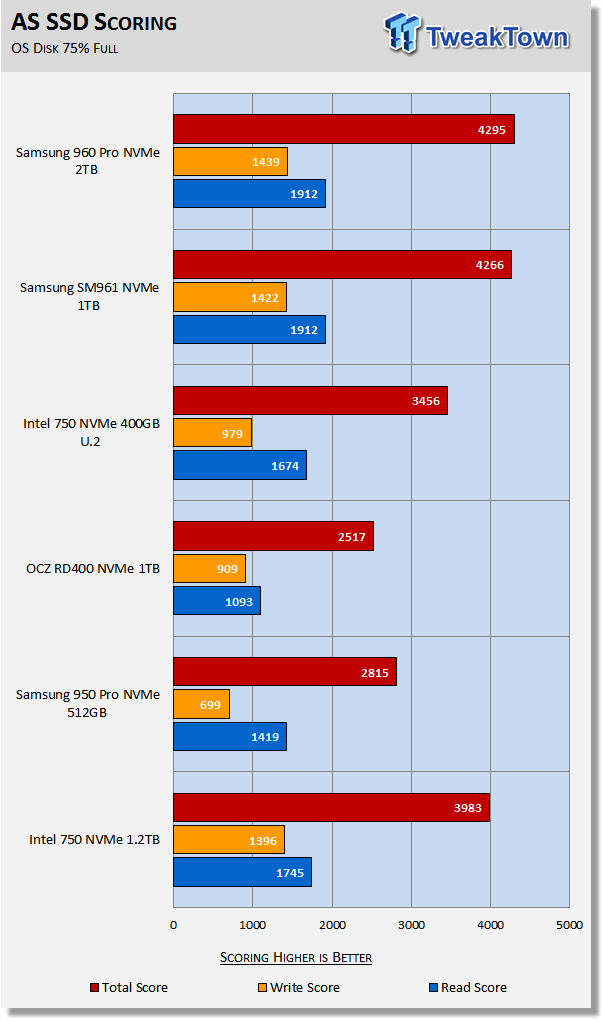
AS SSD is a demanding test, and the 960 Pro sets yet another lab record. This is one of those tests that is greatly impacted in a negative way when data is on the disk as you will see when we get to our MOP testing which is run without data on the disk. We like to show many of our results with data on the disk and the disk running our OS, because this reflects what a user can expect to achieve if their system is well tuned.
Benchmarks (OS) - PCMark Vantage, PCMark 7 & PCMark 8
Moderate Workload Model
We categorize these tests as indicative of a moderate workload environment.
PCMark Vantage - Hard Disk Tests
Version and / or Patch Used: 1.2.0.0
The reason we like PCMark Vantage is because the recorded traces are played back without system stops. What we see is the raw performance of the drive. This allows us to see a marked difference between scoring that other trace-based benchmarks do not exhibit. An example of a marked difference in scoring on the same drive would be empty vs. filled vs. steady state.
We run Vantage three ways. The first run is with the OS drive 75% full to simulate a lightly used OS volume filled with data to an amount we feel is common for most users. The second run is with the OS volume written into a "Steady State" utilizing SNIA's consumer guidelines. Steady state testing simulates a drive's performance similar to that of a drive that been subjected to consumer workloads for extensive amounts of time. The third run is a Vantage HDD test with the test drive attached as an empty, lightly used secondary device.
OS Volume 75% Full - Lightly Used
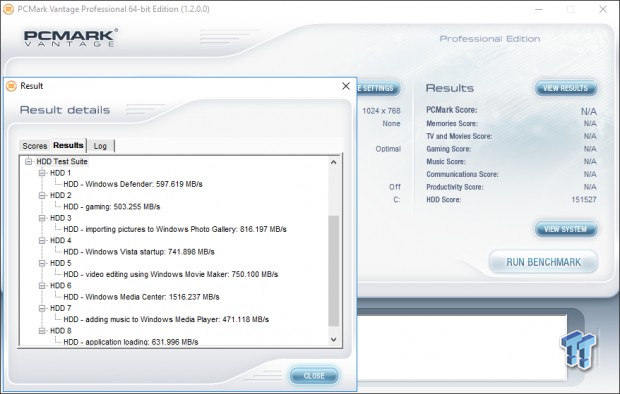
OS Volume 75% Full - Steady State
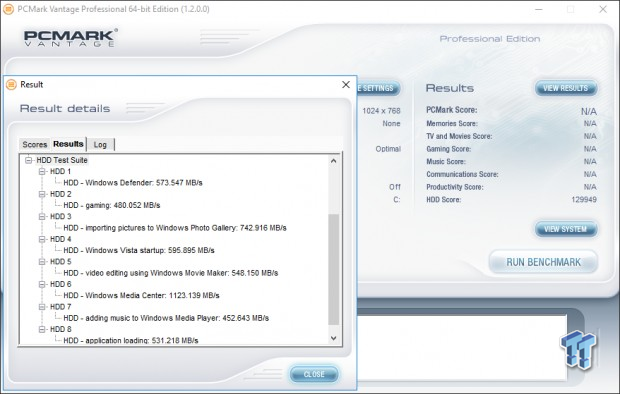
Secondary Volume Empty - FOB
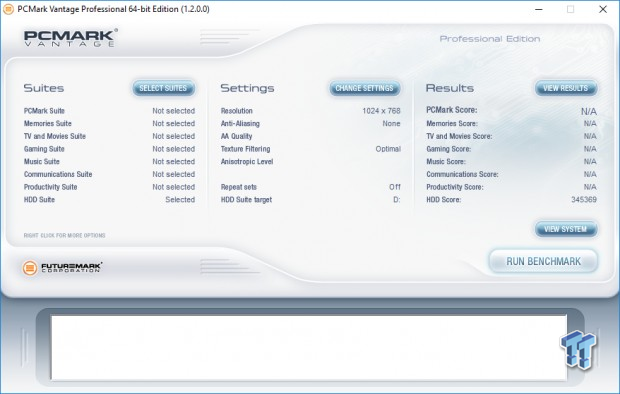
There's a big difference between an empty drive, one that's 75% full/used, and one that's in a steady state.
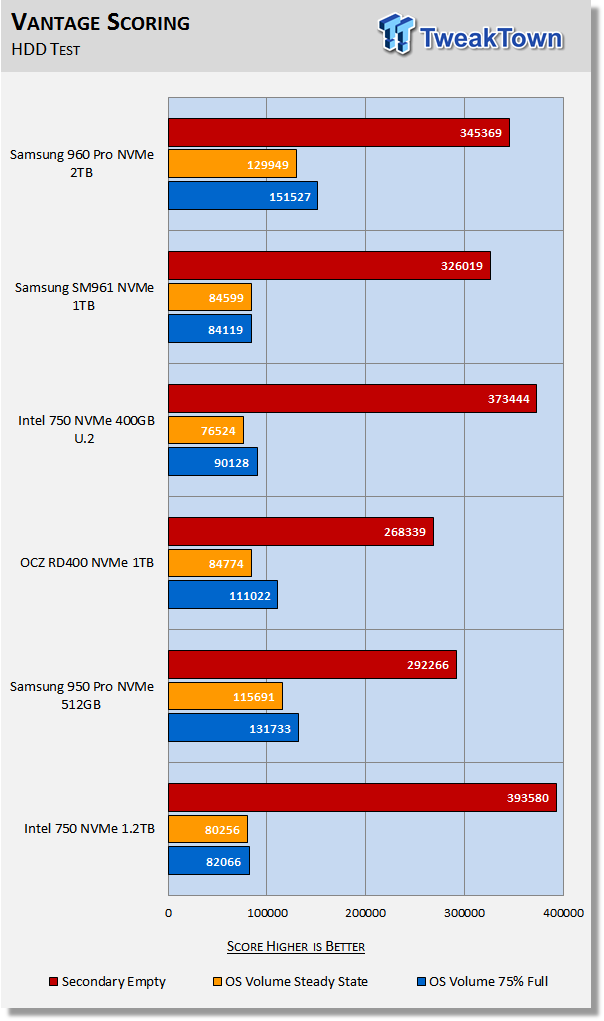
The important scores to pay attention to are "OS Volume Steady State" and "OS Volume 75% full." These two categories are most important because they are indicative of typical of consumer user states. When a drive is in a steady state, it means garbage collection is running at the same time it's reading/writing. This is exactly why we focus on steady state performance.
In a steady-state or a lightly used state, the 960 Pro has no equal. The 960 Pro eviscerates our previous Vantage champion, the 950 Pro, with ease. This testing is an example of why Samsung is the performance leader.
Additionally, it is a perfect illustration of why we believe it is important to test with data on the drive. Without data on the drive, Intel's 750 would be the winner, when in reality it scores 62% lower than the 960 Pro in a realistic user state.
PCMark 7 - System Storage
Version and / or Patch Used: 1.4.0
We will look to Raw System Storage scoring for evaluation because it's done without system stops and, therefore, allows us to see significant scoring differences between drives.
OS Volume 75% Full - Lightly Used
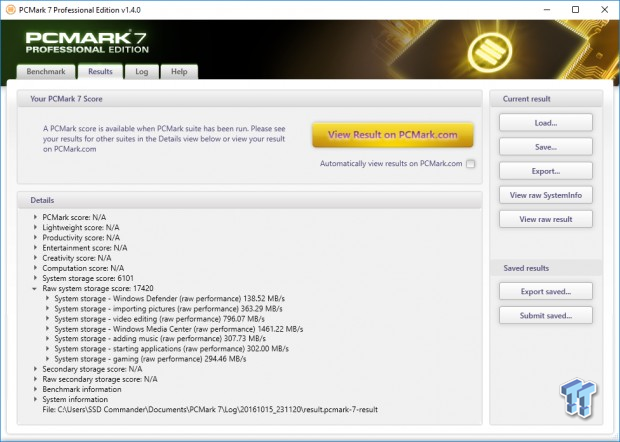
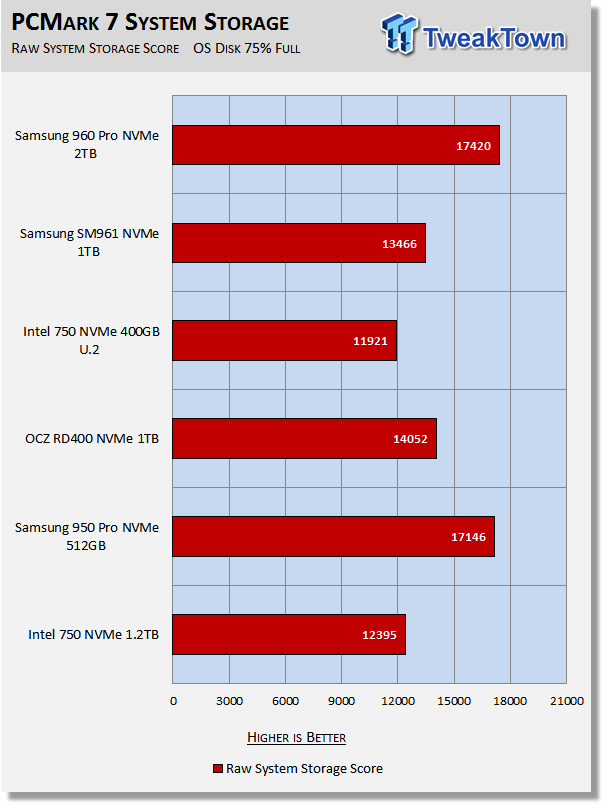
The 960 Pro does what we were expecting from the SM961. The SM961 is a more powerful SSD than the 950 Pro, but it didn't even come close to delivering the performance of the 950 Pro. Why? Because there is not a readily available Samsung NVMe driver designed to run on the SM961.
The 960 Pro sets another lab record for moderate workload performance. We consider moderate workload performance to be the best indicator of how well a drive actually performs in real-world situations.
PCMark 8 - Storage Bandwidth
Version and / or Patch Used: 2.4.304
We use PCMark 8 Storage benchmark to test the performance of SSDs, HDDs, and hybrid drives with traces recorded from Adobe Creative Suite, Microsoft Office, and a selection of popular games. You can test the system drive or any other recognized storage device, including local external drives. Unlike synthetic storage tests, the PCMark 8 Storage benchmark highlights real-world performance differences between storage devices.
OS Volume 75% Full - Lightly Used
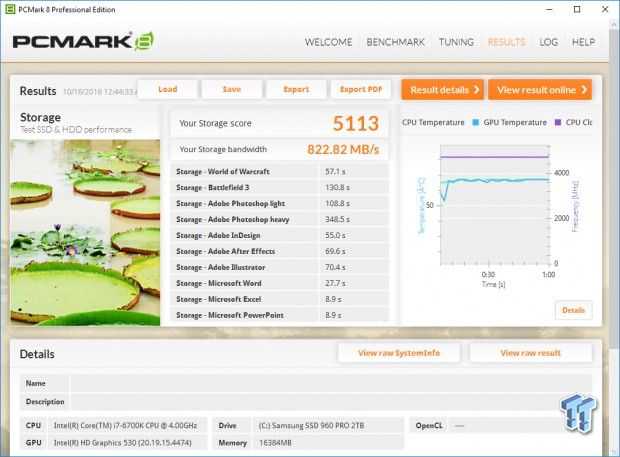
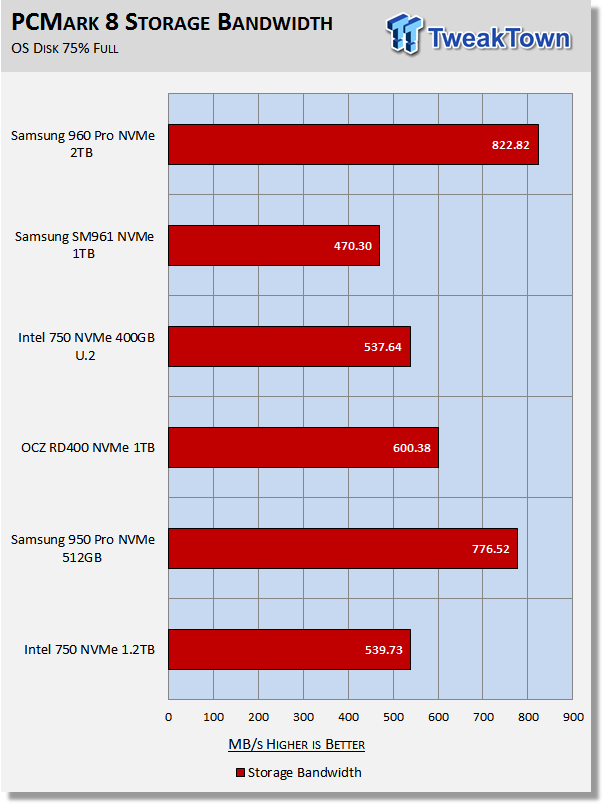
PCMark 8 is the most intensive moderate workload simulation we run. With respect to moderate consumer type workloads, this test is what we consider the best indicator of a drive's performance. This test best highlights what we've been hammering on.
Look at the difference between the 960 Pro and the SM961. Even though the two drives are very similar architecturally, with the Windows 10 NVMe driver, the SM961 as powerful as it is, delivers an embarrassingly low PCMark 8 storage bandwidth of 470 MB/s.
Samsung's proprietary NVMe driver makes all the difference in the world, as evidenced by the record-breaking performance of the 960 Pro.
Benchmarks (Secondary) - IOPS, Response & Transfer Rate
Iometer – Maximum IOPS
Version and / or Patch Used: Iometer 2014
We use Iometer to measure high queue depth performance. (No Partition)
Max IOPS Read
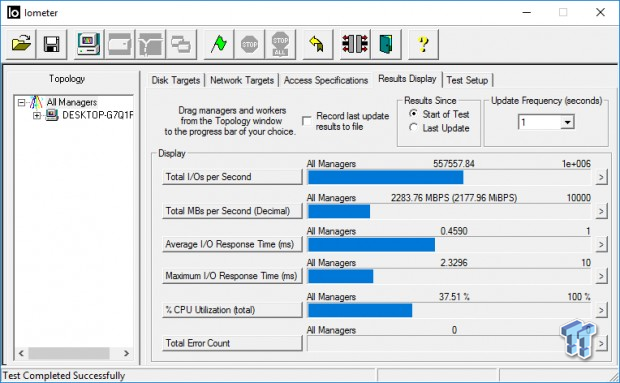
Max IOPS Write
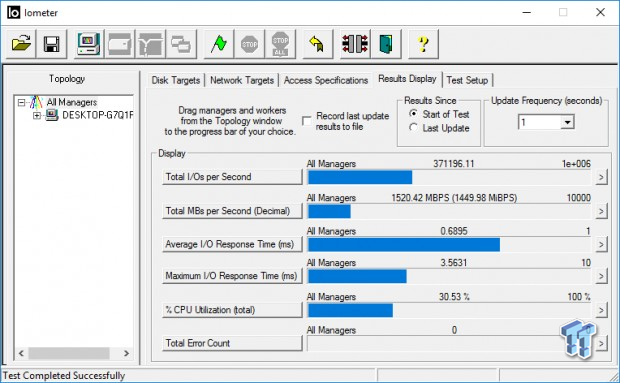
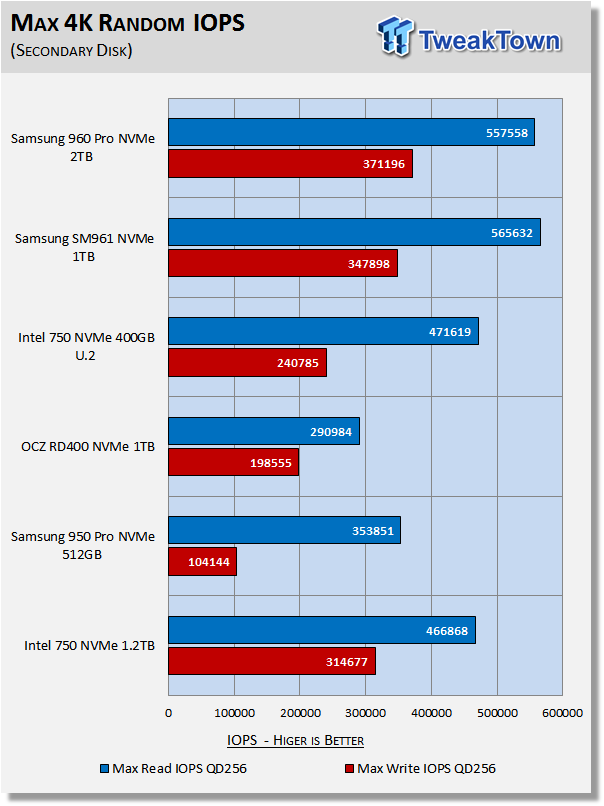
When we tested the SM961, we were blown away by the maximum IOPS that the drive was able to generate. The tiny SM961 was able to best Intel's massive 750 Series 1.2TB AIC. The Intel 750 Series had ruled this test for more than a year.
The 960 Pro delivers similar maximum read IOPS to that of the SM961, but take a look at the maximum random write IOPS that the 960 Pro can generate. 371K random write IOPS is yet another lab record for a consumer SSD.
Iometer – Disk Response
Version and / or Patch Used: Iometer 2014
We use Iometer to measure disk response times. Disk response times are measured at an industry accepted standard of 4K QD1 for both write and read. Each test runs twice for 30 seconds consecutively, with a 5-second ramp-up before each test. We partition the drive/array as a secondary device for this testing.
Avg. Write Response
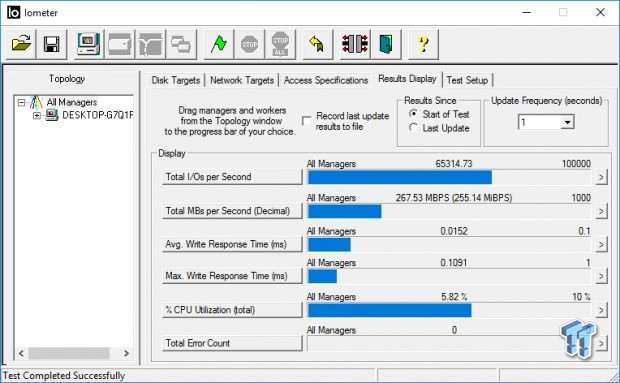
Avg. Read Response
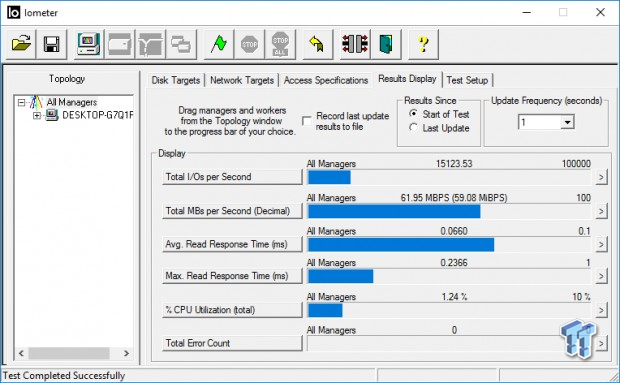
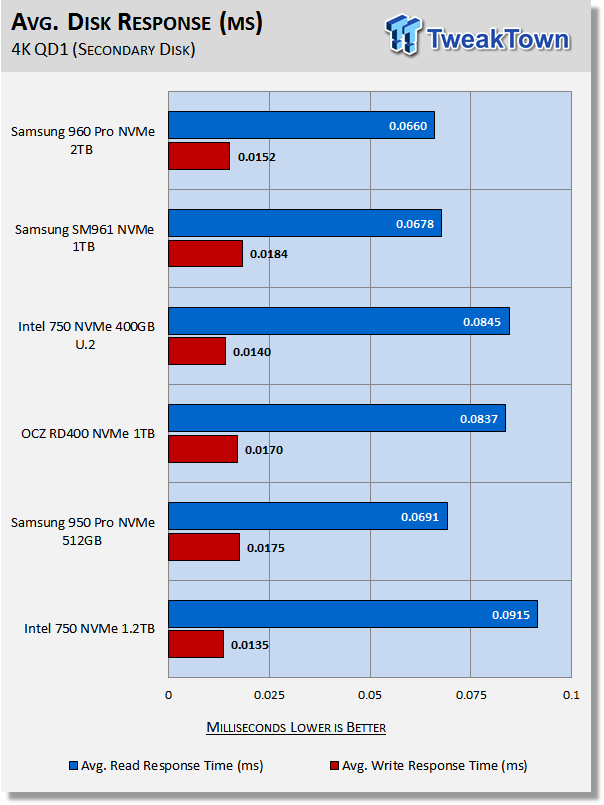
Chalk up another lab record for the 960 Pro. The 960 Pro delivers the best (lowest) read response of any consumer/client SSD we've tested to date. As expected, Intel's 750 Series 1.2TB SSD remains the lab champion for write response.
DiskBench – Transfer Rate
Version and / or Patch Used: 2.6.2.0
We use DiskBench to time a 28.6GB block (9,882 files in 1,247 folders) composed primarily of incompressible sequential and random data as it's transferred from our Toshiba RD400 1TB NVME SSD to our test drive. We then read from a 6GB zip file that's part of our 28.6GB data block to determine the test drive's read transfer rate. Our system is restarted prior to the read test to clear any cached data, ensuring an accurate test result.
Write Transfer Rate
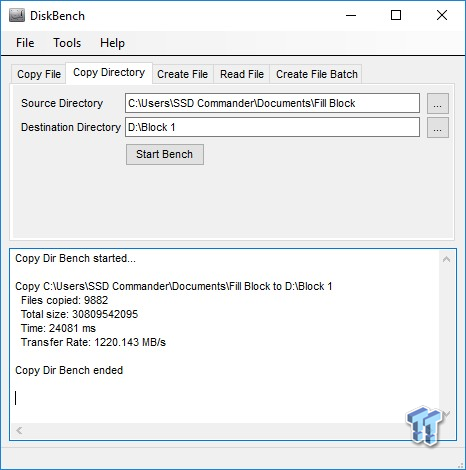
Read Transfer Rate

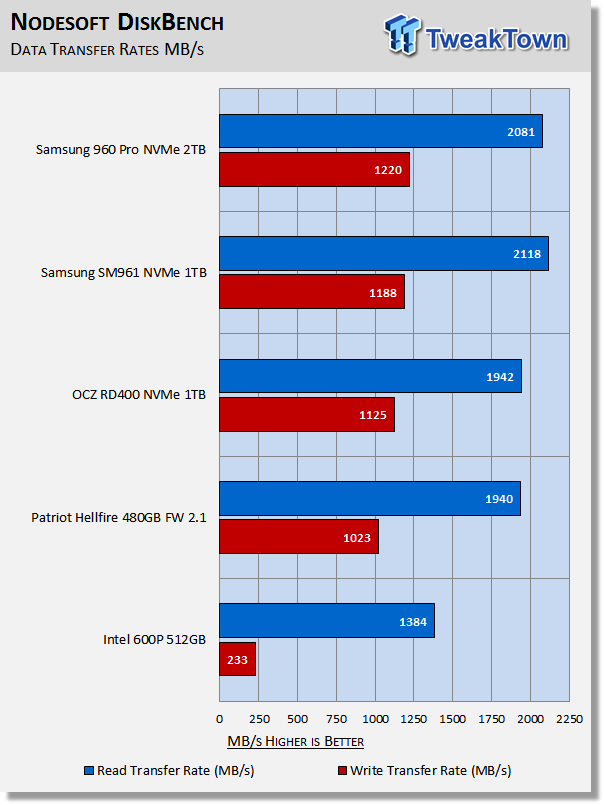
We recently upgraded our test system to Windows 10 build 14393. With that upgrade, write transfer rates almost doubled. The reason for this, as far as we know, is that CPU power switching modes have been relaxed on the latest version of Windows 10. We included the NVMe drives we've tested to date on this build of Windows 10. If you needed a good reason to upgrade to Windows 10 build 14393, this is a good reason.
The 960 Pro sets another lab record, this time for write transfer rates. The write transfer performance of Intel's 600P is laughable. It is hard to imagine that the 600P is an NVMe SSD considering there are mechanical hard drives that can transfer data faster.
Benchmarks (Secondary Volume) - PCMark 8 Extended
Futuremark PCMark 8 Extended
Heavy Workload Model
PCMark 8's consistency test simulates an extended duration heavy workload environment. PCMark 8 has built-in, command line executed storage testing. The PCMark 8 Consistency test measures the performance consistency and the degradation tendency of a storage system.
The Storage test workloads are repeated. Between each repetition, the storage system is bombarded with a usage that causes degraded drive performance. In the first part of the test, the cycle continues until a steady degraded level of performance has been reached. (Steady State)
In the second part, the recovery of the system is tested by allowing the system to idle and measuring the performance after 5-minute long intervals. (Internal drive maintenance: Garbage Collection (GC)) The test reports the performance level at the start, the degraded steady-state, and the recovered state, as well as the number of iterations required to reach the degraded state and the recovered state.
We feel Futuremark's Consistency Test is the best test ever devised to show the true performance of solid state storage in an extended duration heavy workload environment. This test takes on average 13 to 17 hours to complete and writes somewhere between 450GB and 14,000GB of test data depending on the drive. If you want to know what an SSDs steady state performance is going to look like during a heavy workload, this test will show you.
Here's a breakdown of Futuremark's Consistency Test:
Precondition phase:
1. Write to the drive sequentially through up to the reported capacity with random data.
2. Write the drive through a second time (to take care of overprovisioning).
Degradation phase:
1. Run writes of random size between 8*512 and 2048*512 bytes on random offsets for 10 minutes.
2. Run performance test (one pass only).
3. Repeat 1 and 2 for 8 times, and on each pass increase the duration of random writes by 5 minutes.
Steady state phase:
1. Run writes of random size between 8*512 and 2048*512 bytes on random offsets for 50 minutes.
2. Run performance test (one pass only).
3. Repeat 1 and 2 for 5 times.
Recovery phase:
1. Idle for 5 minutes.
2. Run performance test (one pass only).
3. Repeat 1 and 2 for 5 times.
Storage Bandwidth
PCMark 8's Consistency test provides a ton of data output that we use to judge a drive's performance.
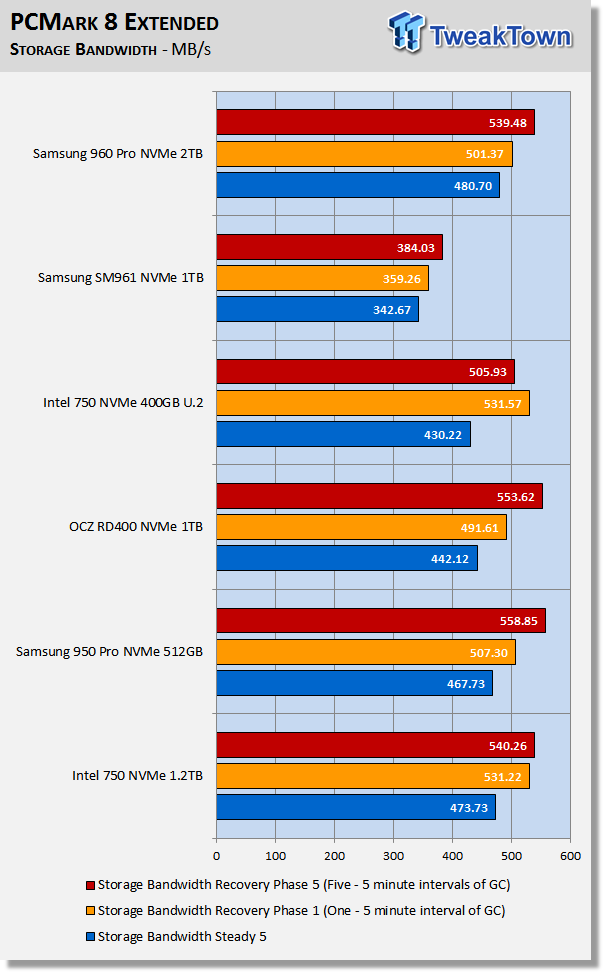
We consider steady state bandwidth (the blue bar) our test that carries the most weight in ranking a drive/arrays heavy workload performance. Performance after Garbage Collection (GC) (the orange and red bars) is what we consider the second most important consideration when ranking a drive's performance. Trace-based steady state testing is where true high performing SSDs are separated from the rest of the pack.
In a steady-state heavy workload environment, the 960 Pro is the best performing SSD we've ever tested. The 960 Pro manages to unseat the long-time champion of this test, the Intel 750 1.2TB AIC. Even its enterprise DNA is not enough to save the Intel 750 from the new performance champion; Samsung's 960 Pro.
Again, we see the difference a driver makes. The 960 Pro's closest cousin, the SM961, without a dedicated driver is no match for the competition.
Total Access Time (Latency)
We chart our test subject's storage bandwidth as reported at each of the test's 18 trace iterations. This gives us a good visual perspective of how our test subjects perform as testing progresses. This chart sheds more light on how the drives perform as they progress through the testing phases.
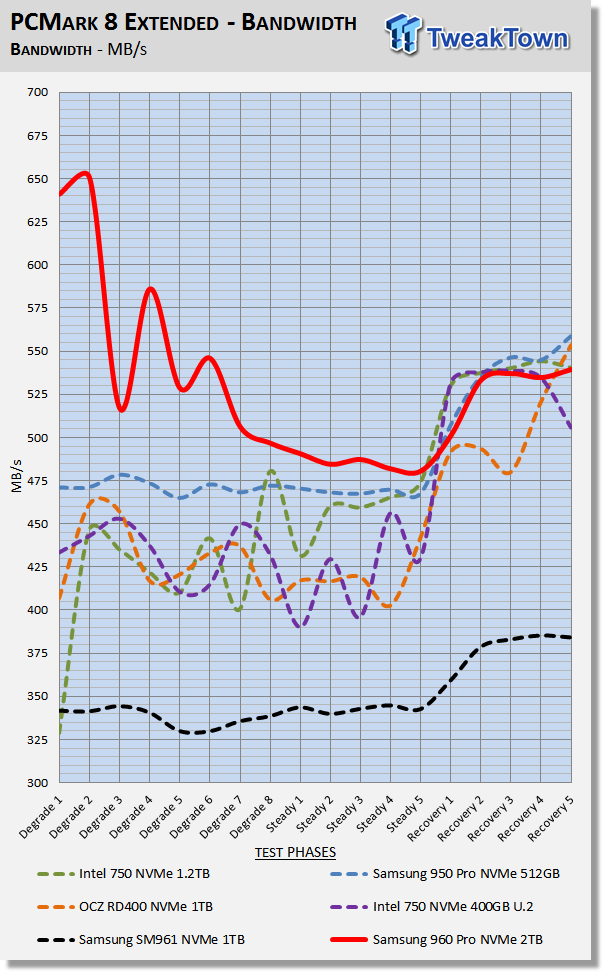
We chart the total time the disk is accessed as reported at each of the test's 18 trace iterations. This helps shed some light on how the drive performs at each of the 18 phases of this test.
OCZ's RD400 and Samsung's 950 Pro both recover better than the 960 Pro, but that's not what matters to us. Look at the performance the 960 Pro delivers at the degrade 2 phase of this test. Degrade 2 is indicative of how the 960 Pro will perform in a moderate workload environment before reaching a full steady-state which only occurs when running heavy duty sustained workloads.
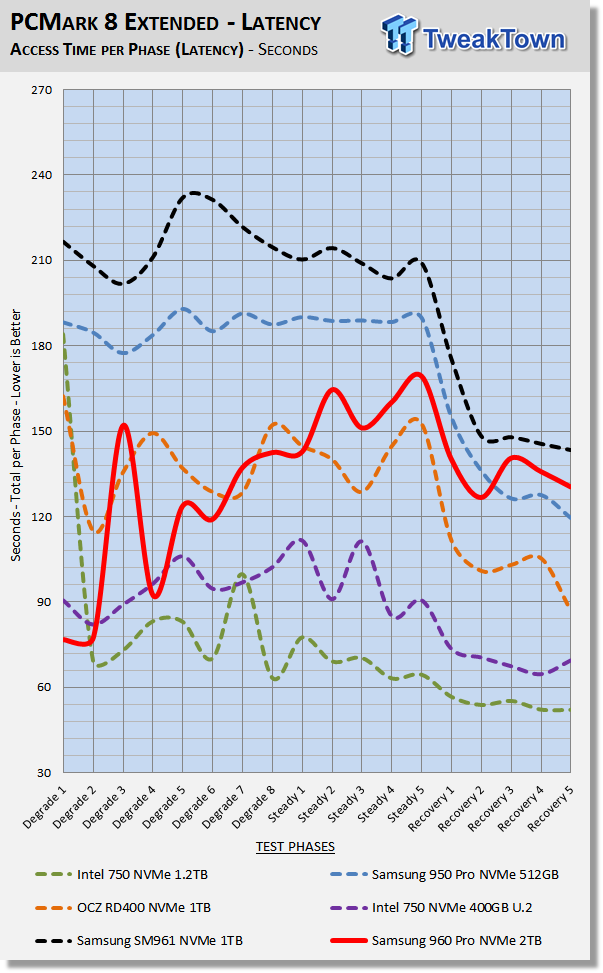
Disk Busy Time
Disk Busy Time is how long the disk is busy working. We chart the total time the disk is working as reported at each of the tests 18 trace iterations.
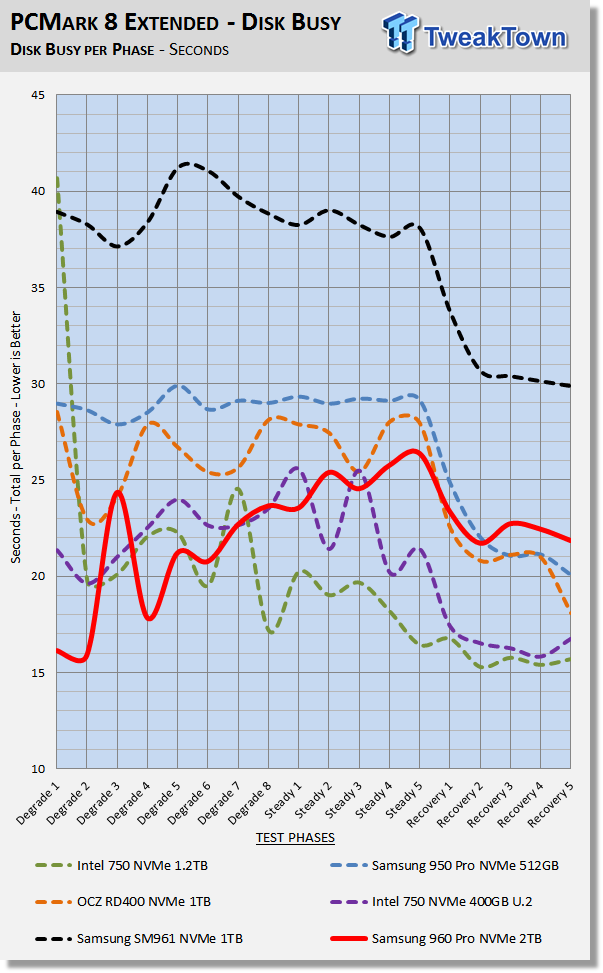
When latency is low, disk busy time is low as well.
Data Written
We measure the total amount of random data that our test drive/array is capable of writing during the degradation phases of the consistency test. Pre-conditioning data is not included in the total. The total combined time that degradation data is written to the drive/array is 470 minutes. This can be very telling. The better a drive/array can process a continuous stream of random data; the more data will be written.

Overprovisioning and write latency are the biggest factors that determine the outcome of this portion of the test. The Intel drives have a healthy dose of overprovisioning which is the reason they dominate this portion of our testing.
Benchmarks (Secondary Volume) – 70/30 Mixed Workload
70/30 Mixed Workload Test (Sledgehammer)
Version and / or Patch Used: Iometer 2014
Heavy Workload Model
This test hammers a drive so hard we've dubbed it "Sledgehammer". Our 70/30 Mixed Workload test is designed to simulate a heavy-duty enthusiast/workstation steady-state environment. We feel that a mix of 70% read/30% write, full random 4K transfers best represents this type of user environment. Our test allows us to see the drive enter into and reach a steady state as the test progresses.
Phase one of the test preconditions the drive for 1 hour with 128K sequential writes. Phase two of the test runs a 70% read/30% write, full random 4K transfer workload on the drive for 1 hour. We log and chart (phase two) IOPS data at 5-second intervals for 1 hour (720 data points). 60 data points = 5 minutes.
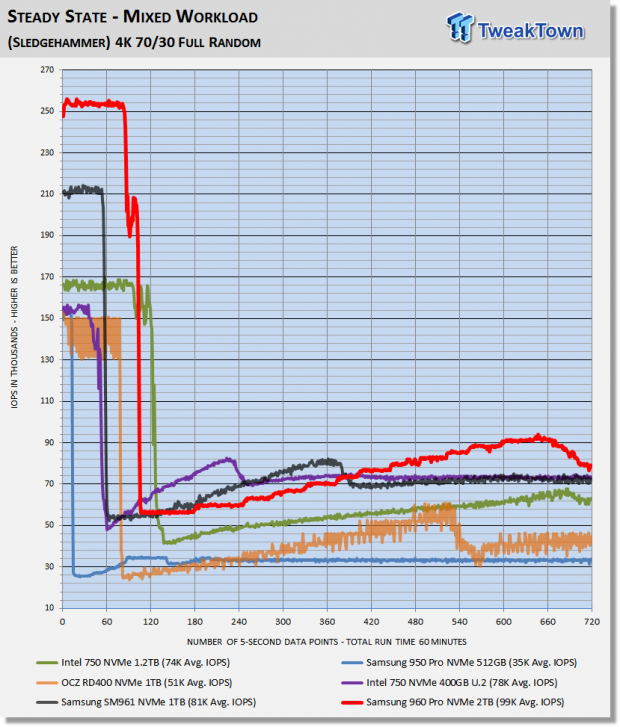
What we like about this test is that it reflects reality. Everything lines up, as it should. Consumer drives don't outperform Enterprise-Class SSDs that were designed for enterprise workloads. Consumer drives based on old technology are not outperforming modern Performance-Class SSDs, etc.
This is a brutal test, and the 960 Pro eats it alive. The 960 Pro delivers an astounding 99K IOPS average performance across the span of this test. If the 960 Pro were overprovisioned by even just a little bit, it would likely beat the Intel 750's by at least 50K. Another lab record goes to the mighty 960 Pro.
Maxed-Out Performance (MOP)
This testing is just to see what the drive is capable of in an FOB (Fresh Out of Box) state under optimal conditions. We are utilizing empty volumes of Windows 10 and Windows Server 2008 R2 64-bit for this testing. Same Hardware, just an OS change.
Windows 10 MOP
Samsung 960 Pro 2TB
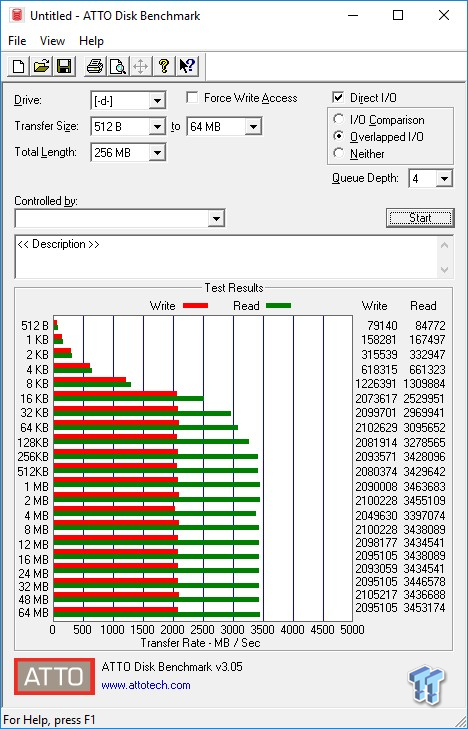
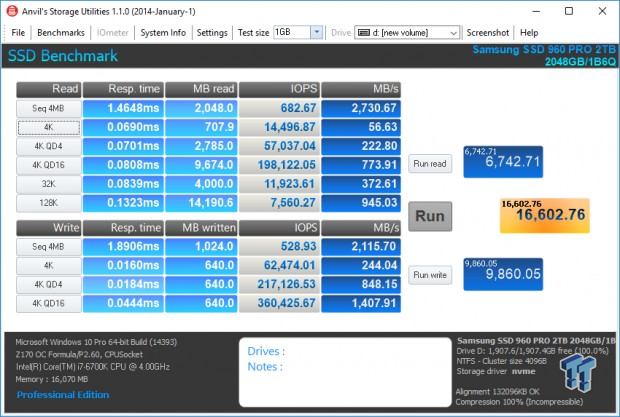
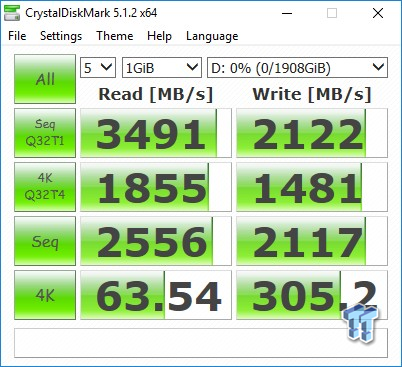
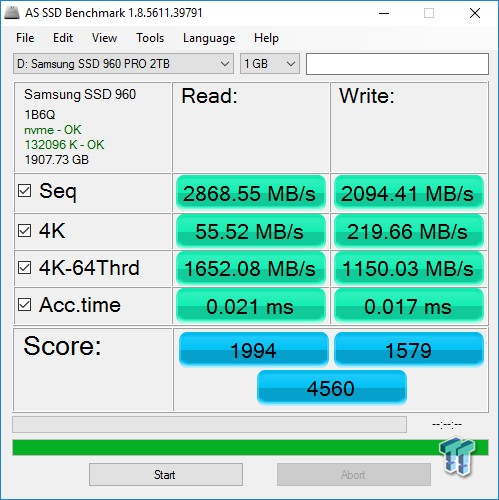
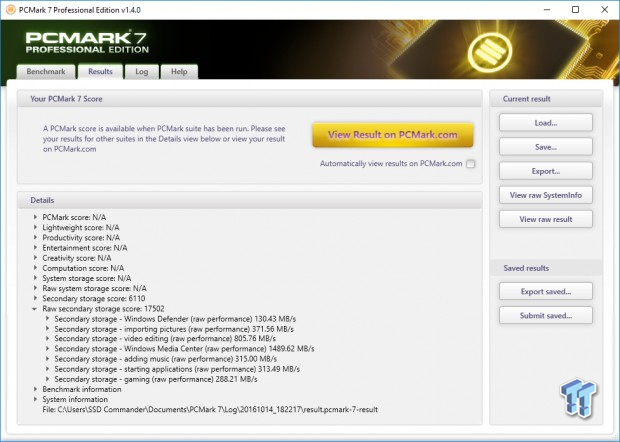
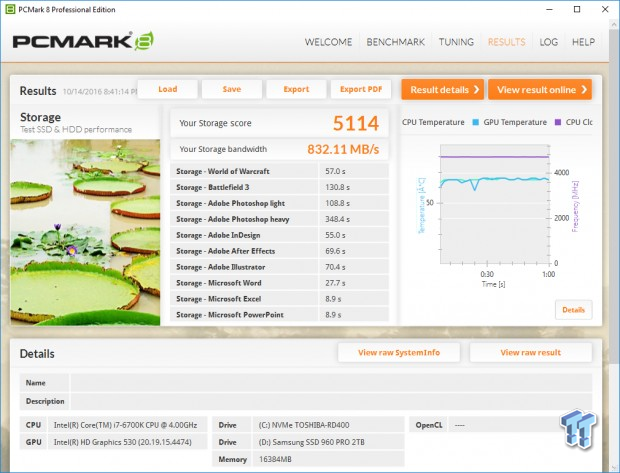
Windows Server 2008 R2 MOP
Samsung 960 Pro 2TB
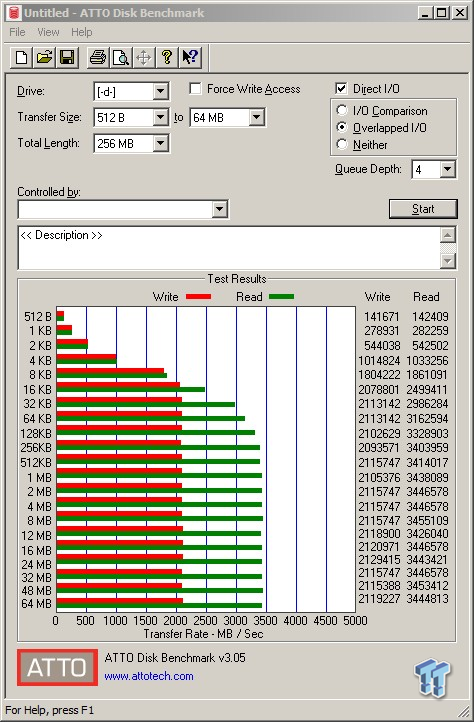
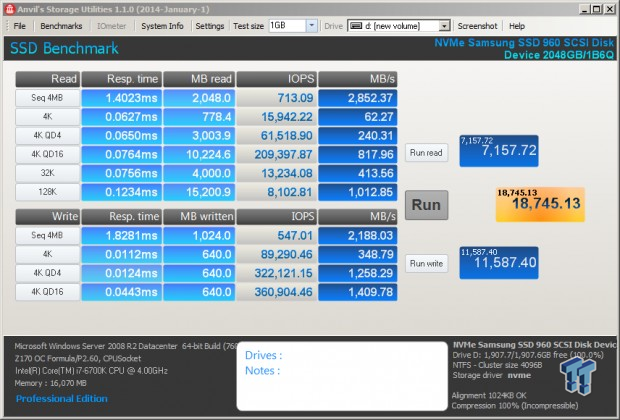
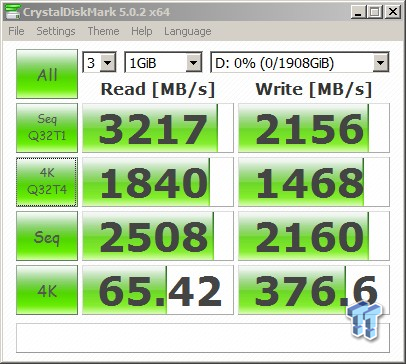

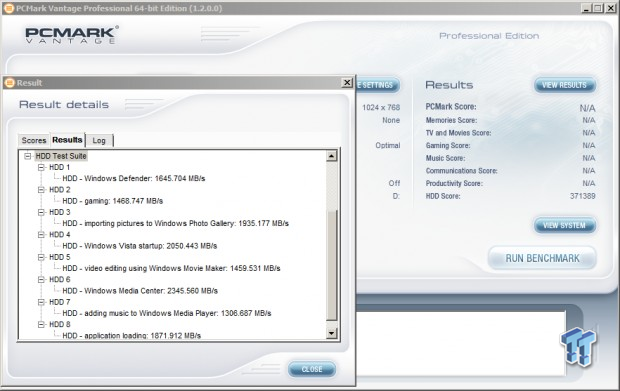
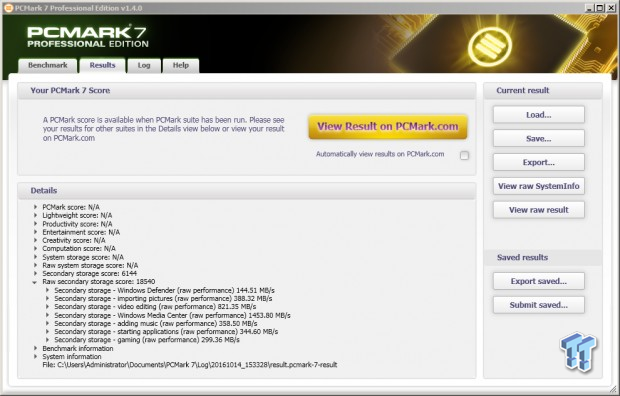
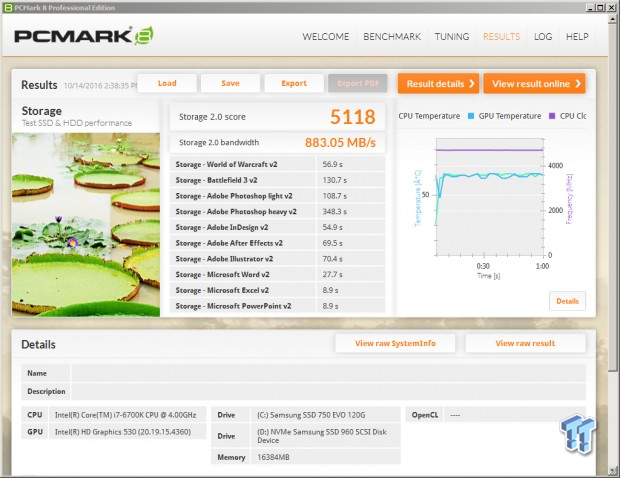
Otherworldly performance on Server 2008. This is most similar to the kind of performance you could expect from Windows 7 as long as you are running your 960 Pro on Samsung's NVMe driver.
Do not even think about running your 960 Pro on the MS NVMe driver for Windows 7/Server 2008 because it is even worse than the MS NVMe driver for Windows 10.
Final Thoughts

A new level of performance and capacity on the M.2 form factor is what Samsung's 2TB 960 Pro NVMe SSD brings to the table. What more could you ask for? Sure, the drive is expensive, but look what you get. We can't think of any other piece of hardware that can impact one's overall user experience like the 960 Pro can. It is hard to believe that such a tiny SSD can deliver performance on this level. This is a testament to Samsung's leadership in the SSD arena.
If you just can't see spending $1300 on an SSD, then you won't have to wait long, because the next bullet in Samsung's chamber is the low-cost 960 EVO, which is the second-fastest SSD ever made. However, if you want the best SSD ever made then Samsung's 2TB 960 Pro is THE SSD for you. The 960 Pro is not just another piece of hardware; it is an investment in your user experience. The Samsung 960 Pro is superior to the competition in every way. If you are on the fence waiting for Optane to hit, don't hold your breath, because it will likely be a long wait and even more expensive.
As we explained earlier, we do not have Samsung's newest NVMe driver in hand at this time. The new driver might deliver even better performance, but we feel this is unlikely given the results we were able to extract from the 960 Pro. We do know a bit more about Samsung's revamped Magician software. The new Magician will have an intuitive user interface that will visually display what drive you are running, allow you to secure-erase individual files, instantly see the condition of the drive in an easy to decipher format, check system compatibility, along with many other useful features.
Needless to say, the user experience delivered by Samsung's 960 Pro is second to none. The drive is nothing short of incredible. If you have to have the best, then you have to have a 2TB Samsung 960 Pro. It is as simple as that. Samsung's 960 Pro 2TB M.2 NVMe PCIe SSD is TweakTown recommended.
Pros:
- Performance
- Capacity
- Build Quality
- Most Appealing Form Factor
Cons:
- Price (maybe)


